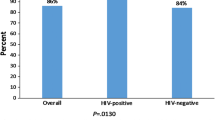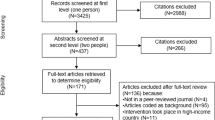Abstract
We studied the influence of the Seattle, Washington, needle-exchange program on sharing of drug injection equipment (syringes, drug cookers, filtration cotton) to identify potential gaps in risk reduction and to understand in greater detail the lack of an association between exchange use and risk of hepatitis B or C virus transmission. In a cohort of 2,208 injection drug users who completed a 1-year follow-up visit, we measured the association between needle-exchange use at study enrollment (ever vs. never) and injection risk behavior at the follow-up. Control for confounding was carried out using both logistic regression and propensity score analytic methods to estimate the adjusted odds ratio (AOR). In both univariate and multivariate analyses ,needle-exchange use was associated with a lower likelihood of injection with a used syringe (AOR-0.7,95% confidence limit 0.5,0.9). There was no association between exchange use and cooker or cotton sharing (AOR-0.8,95% confidence limit 0.6, 1.1) or between exchange use and use of a common syringe to divide drugs (AOR=0.9). This analysis suggests that risk reduction measures adopted by users of the Seattle exchange may not be sufficient to prevent transmission of all blood-borne viruses, including hepatitis C virus. Creater awareness of the infection risk associated with these practices may help curb this type of equipment sharing and ultimately prevent disease transmission.
Similar content being viewed by others
References
Paone D, Clark J, Shi Q, Purchase D, Des Jarlais DC. Syringe exchange in the Unied States, 1996: a National Profile.Am J Public Health. 1999;89:43–46.
Ball AL, Rana S, Dehne KL. HIV prevention among injecting drug users: responses in developing and transitional countries.Public Health Rep. 1998;113(suppl):170–181.
Donoghoe MC, Stimson GV, Dolan K, Aldritt L. Changes in HIV risk behavior in clients of syringe-exchange schemes in England and Scotland.AIDS. 1989;3:267–272.
Hagan H, Des Jarlais DC, Purchase D, Friedman SR, Reid TR, Bell TA. An interview study of participants in the Tacoma, Washington, syringe exchange.Addiction. 1993; 88:1691–1697.
Schoenbaum EE, Hartel DM, Gourevitch MN. Needle exchange use among a cohort of injecting drug users.AIDS. 1996;10:1729–1734.
Vlahov D, Junge B. The role of needle exchange programs in HIV prevention.Public Health Rep. 1998;113(suppl):75–80.
Bluthenthal RN, Kral AH, Erringer EA, Edlin BR. Use of an illegal syringe exchange and injection-related risk behaviors among street-recruited injection drug users in Oakland, California, 1992 to 1995.J Acquir Immune Defic Syndr Hum Retrovirol. 1998; 18:505–511.
MacGowan RJ, Sterk CE, Long A, Cheney R, Seeman M, Anderson JE. New needle and syringe use, and use of needle exchange programmes by street recruited injection drug users in 1993.Int J Epidemiol. 1998;27:302–308.
Normand J, Vlahov D, Moses LE, eds.Preventing HIV Transmission: the Role of Sterile Needles and Bleach. Washington, DC: National Academy Press; 1995.
Watters J, Estilo MJ, Clark GL, Lorvick J. Syringe and needle exchange as HIV/AIDS prevention for injection drug users.JAMA. 1994;271:115–120.
Des Jarlais DC, Marmor M, Paone D et al. HIV incidence among injecting drug users in New York City syringe exchange programmes.Lancet. 1996;348:987–991.
Hagan H, Des Jarlais DC, Friedman SR, et al. Reduced risk of hepatitis B and hepatitis C associated with participation in the Tacoma syringe exchange.Am J Public Health 1995;85:1531–1537.
Hurley S, Jolley DJ, Kaldor JM. Effectiveness of needle-exchange programmes for prevention of HIV infection.Lancet. 1997;349:1797–1800.
Kaplan EH, Heimer R. A circulation theory of needle exchange.AIDS. 1994;8:567–574.
Strathdee SA, Patrick DM, Currie S et al. Needle exchange is not enough: lessons from the Vancouver injection drug use study.AIDS. 1997;11:F59-F65.
Bruneau J, Lamothe F, Franco E, et al. High rates of HIV infection among injection drug users participating in needle exchange programs in Montreal: results of a cohort study.Am J Epidemiol. 1997;146:994–1002.
Hagan H, McGrough JP, Thiede H, Weiss NS, Hopkins S, Alexander ER. Syringe exchange and risk of hepatitis B and C viruses.Am J Epidemiol. 1999;149:203–213.
Schechter MT, Strathdee SA, Cornelisse PG, et al. Do needle exchange programmes increase the spread of HIV among injection drug users? An investigation of the Vancouver outbreak.AIDS. 1999;13:F45-F51.
Hagan H, Thiede H, Weiss NS, Hopkins S, Alexander ER. Volunteer bias in nonrandomized evaluations of the efficacy of needle exchange programs.J Urban Health. 2000;77:93–102.
D'Agostino RB. Propensity score methods for bias reduction in the comparison of a treatment to a non-randomized control group.Stat Med. 1998;17:2265–2281.
Rosenbaum PR, Rubin DB. Reducing bias in observational studies using subclassification on the propensity score.J Am Stat Assoc. 1984;79:516–524.
Cochran WG. The effectiveness of adjustment by subclassification in removing bias in observational studies.Biometrics. 1968;24:295–313.
Paone D, Clark J, Shi Q, Purchase D, Des Jarlais DC. Syringe exchange in the United States 1996: a national profile.Am J Public Health. 1999;89:43–46.
Mantel N, Haenszel W. Statistical aspects of the analysis of data from retrospective studies of disease.J Natl Cancer Inst. 1959;22:719–748.
Crofts N, Aitken CK. Incidence of blood-borne virus infection and risk behaviors in a cohort of injecting drug users in Victoria, 1990–1995.Med J Aus. 1997;167:17–20.
Hunter GM, Donoghoe MC, Stimson GV, Rhodes T, Chalmers CP. Changes in the injecting risk behavior of injecting drug users in London, 1990–1993.AIDS. 1995;9:493–501.
McCoy CB, Metsch LR, Chirwood DD, Shapshak P, Comersford ST. Parenteral transmission of HIV among injection drug users: assessing the frequency of multiperson use of needles, syringes, cookers, cotton and water.J Acquir Immune Defic Syndr Hum Retrovirol. 1998;18(suppl 1):S25-S29.
Hagan H, Thiede H, Weiss NS, Hopkins SG, Duchin JS, Alexander ER. Sharing of drug preparation equipment as a risk factor for hepatitis C virus incidence.Am J Public Health. In press. 2000.
Gerberding JL. Management of occupational exposures to blood-borne viruses.New Engl J Med. 1995;332:444–451.
Tortu S, Deren D, Beardsley M, Hamid R. Factors associated with needle exchange use in East Harlem, New York City.J Drug Issues. 1996;26:735–749.
Author information
Authors and Affiliations
Corresponding author
Rights and permissions
About this article
Cite this article
Hagan, H., Thiede, H. Changes in injection risk behavior associated with participation in the seattle needle-exchange program. J Urban Health 77, 369–382 (2000). https://doi.org/10.1007/BF02386747
Issue Date:
DOI: https://doi.org/10.1007/BF02386747




